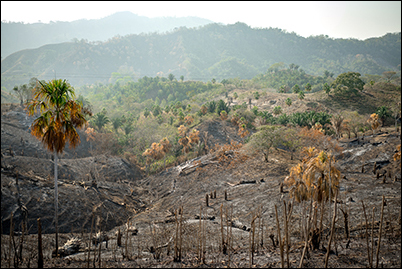Over the years, isolated research efforts in Colombia have highlighted the ecological importance of natural wildfires in some areas and the risks of fire-driven biodiversity losses in others. However, these efforts do not form part of a consolidated research agenda on fire ecology. As a result, strategies to deal with wildfires are short-term attempts at damage control and contribute little to our understanding of fire as an integral part of Colombian ecosystems.
The Humboldt Research Institute organized a Fire Ecology Colloquium in Bogotá in June 2016, with the aim of bringing together fire experts and environmental management institutions to develop and agree on a research agenda. Participants included representatives from environmental organizations, public institutions, nongovernmental organizations, universities, and a representative from the U.S. Forest Service.
National fire management policies in countries rich in biodiversity might provide lessons for Colombia.
During the colloquium, scientists identified major knowledge gaps and key scientific questions. Participants reached five major conclusions. First, they agreed that there is an urgent need to define a fire research agenda in Colombia and to have a wider discussion during restoration, conservation, and management planning about how fire is perceived.
Second, they called for fire education efforts to be improved for all segments of society. National fire management policies in countries rich in biodiversity might provide lessons for Colombia, a country that ranks second in biodiversity in the world. Third, participants agreed that it is essential to develop a fundamental understanding of the role of fire and natural fire regimes in Colombian ecosystems.

Fourth, attendees stressed the need to better document cultural variability in perceptions and the use of fire for such purposes as clearing land for agriculture, hunting, or cattle ranching throughout Colombia. Finally, cooperation and coordination among Colombia’s institutions were seen as essential to guaranteeing the quality, integrity, and availability of information regarding fire in Colombia.
Several initiatives emerged from the colloquium. One working group is synthesizing the main points of discussion and prioritized research questions in a publication for Colombian researchers and environmental institutions. A second publication will discuss the importance of these types of initiatives in a global context, especially for megadiverse countries with poor or nonexistent fire ecology research. Another group is compiling current knowledge of fire and fire regimes in Colombia, as well as linking scenarios of climate change to fire occurrence and effects (Figure 1).

Under current climate change trends, the increasing frequency of fire in erstwhile fire-free environments is a major factor in the loss of biodiversity in the tropics. Monolithic approaches to fire control can blind us to the role that fire plays in maintaining biodiversity in other ecosystems.
Defining a research agenda on fire ecology is an opportunity to push for a wider conversation about how fire is integrated into strategies for conservation, restoration, and resource management.
In megadiverse countries like Colombia, defining a research agenda on fire ecology is an opportunity to identify urgent research questions and knowledge gaps that must be filled while pushing for a wider conversation about how fire is regarded and integrated into strategies for conservation, restoration, and resource management.
—Susana Rodríguez-Buriticá (email: [email protected]), Mauricio Aguilar-Garavito, and Natalia Norden, Alexander von Humboldt Biological Resources Research Institut, Bogotá, Colombia
Citation:
Rodríguez-Buriticá, S.,Aguilar-Garavito, M., and Norden, N. (2017), Identifying a fire ecology research agenda for Colombia, Eos, 98, https://doi.org/10.1029/2017EO065869. Published on 10 January 2017.
Text © 2017. The authors. CC BY-NC-ND 3.0
Except where otherwise noted, images are subject to copyright. Any reuse without express permission from the copyright owner is prohibited.

